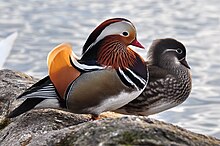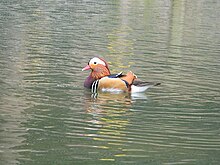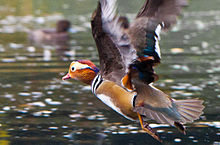Mandarin Duck
| Mandarin Duck | |
|---|---|
 | |
| A pair in Switzerland | |
| Conservation status | |
| Scientific classification | |
| Kingdom: | Animalia |
| Phylum: | Chordata |
| Class: | Aves |
| Order: | Anseriformes |
| Family: | Anatidae |
| Genus: | Aix |
| Species: | A. galericulata |
| Binomial name | |
| Aix galericulata (Linnaeus, 1758) | |
The Mandarin Duck (Aix galericulata), or just Mandarin, is a medium-sized perching duck, closely related to the North American Wood Duck. It is 41–49 cm long with a 65–75 cm wingspan.
Description
The adult male is a striking and unmistakable bird. It has a red bill, large white crescent above the eye and reddish face and "whiskers". The breast is purple with two vertical white bars, and the flanks ruddy, with two orange "sails" at the back. The female is similar to female Wood Duck, with a white eye-ring and stripe running back from the eye, but is paler below, has a small white flank stripe, and a pale tip to its bill.The Mandarin ducklings are almost identical in look to Wood ducklings, and appear very similar to Mallard ducklings. The ducklings can be distinguished from Mallard ducklings because the eye-stripe of Mandarin ducklings (and Wood ducklings) stops at the eye, while in Mallard ducklings it reaches all the way to the bill.
Mutations
There are various mutations of the Mandarin Duck found in captivity. The most common is the white Mandarin Duck. Although the origin of this mutation is unknown, it is presumed that the constant pairing of related birds and selective breeding led to recessive gene combinations leading to genetic conditions including albinism.
Distribution and habitat
The species was once widespread in eastern Asia, but large-scale exports and the destruction of its forest habitat have reduced populations in eastern Russia and in China to below 1,000 pairs in each country; Japan, however, is thought to still hold some 5,000 pairs.
Specimens frequently escape from collections, and in the 20th century a large feral population was established in Great Britain; more recently small numbers have bred in Ireland, concentrated in the parks of Dublin. There are now about 7000 in Britain, and other populations on the European continent, the largest in the region of Berlin.
Black Mountain, North Carolina also has a limited population.There is also a free-flying feral population of several hundred mandarins in Sonoma County, California. This population is the result of several mandarin ducks escaping from captivity, then going on to reproduce in the wild.
Behaviour and ecology
Breeding
In the wild, Mandarin Ducks breed in densely wooded areas near shallow lakes, marshes or ponds. They nest in cavities in trees close to water and during the spring, the females lay their eggs in the tree's cavity after mating. Although the male may defend the female during incubation, he himself does not incubate the eggs and leaves before they hatch. Shortly after the ducklings hatch, their mother flies to the ground and coaxes the ducklings to leap from the nest. After all of the ducklings are out of the tree, they will follow their mother to a nearby body of water. The Asian populations are migratory, overwintering in lowland eastern China and southern Japan.
Food and feeding
Mandarins feed by dabbling or walking on land. They mainly eat plants and seeds, especially beechmast. The species will also add snails, insects and small fish to its diet. The diet of Mandarin Ducks changes seasonally, in the fall and winter, they mostly eat acorns and grains. In the spring they mostly eat insects, snails, fish and aquatic plants. In the summer, they eat dew worms, small fish, frogs, mollusks, and small snakes.They feed mainly near dawn or dusk, perching in trees or on the ground during the day.
Threats
Predation of the Mandarin Duck varies due to its geological ranges. Mink, raccoon dogs, otters, polecats, eurasian eagle owls, and grass snakes are all predators of the Mandarin Duck. The greatest threat to the Mandarin Duck is habitat loss due to loggers. Hunters are also a threat to the Mandarin Duck, because oftentimes, they are unable to recognize the Mandarin in flight and as a result, many are shot on accident. Mandarin ducks are not hunted for food, however they are still poached because their extreme beauty is prized.
In Chinese culture
Mandarin Ducks, which are referred to by the Chinese as Yuan-yang (simplified Chinese: 鸳鸯; traditional Chinese: 鴛鴦; pinyin: yuān yāng), where yuan(鴛) and yang(鴦) respectively stand for male and female Mandarin Ducks.
In traditional Chinese culture, Mandarin Ducks represent a life-time couple, unlike many other species of ducks. Hence they are frequently featured in Chinese art and are regarded as a symbol of conjugal affection and fidelity.
A Chinese proverb for loving couples uses the Mandarin Duck as a metaphor: "Two mandarin ducks playing in water" (simplified Chinese: 鸳鸯戏水; traditional Chinese: 鴛鴦戲水; pinyin: yuān yāng xì shuǐ). The Mandarin Duck symbol is also used in Chinese weddings, because in traditional Chinese lore they symbolize wedded bliss and fidelity.
Because the male and female plumages of the Mandarin Duck are so unalike, yuan-yang is frequently used colloquially in Cantonese to mean an "odd couple" or "unlikely pair" – a mixture of two different types of same category. For example, yuanyang (drink) and yuan-yang fried rice.














No comments:
Post a Comment